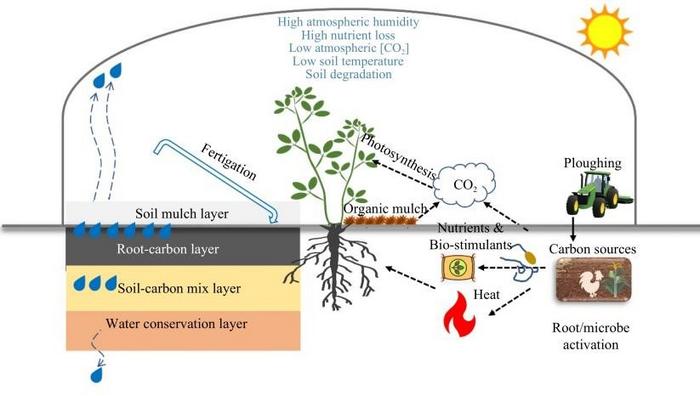A research team has developed a novel conceptual framework for designing plastic-greenhouse soil profiles that cater to the needs of smallholder farmers. The soil profile includes four functional layers: a soil mulch layer for preventing evaporation, a root-carbon layer for nutrient, CO2, and heat generation, a soil-carbon mix layer for buffering and nutrient supply, and a water conservation layer to store water and nutrients. Exemplified by the sand mulching in Almería, Spain, and the sunken profile in Shouguang, China, this affordable and sustainable profile design holds significant promise for enhancing horticultural production globally. Future research will focus on adapting these profiles to local conditions and optimizing organic input to improve both plant and soil health, ultimately supporting sustainable agricultural practices.

Credit: The authors
A research team has developed a novel conceptual framework for designing plastic-greenhouse soil profiles that cater to the needs of smallholder farmers. The soil profile includes four functional layers: a soil mulch layer for preventing evaporation, a root-carbon layer for nutrient, CO2, and heat generation, a soil-carbon mix layer for buffering and nutrient supply, and a water conservation layer to store water and nutrients. Exemplified by the sand mulching in Almería, Spain, and the sunken profile in Shouguang, China, this affordable and sustainable profile design holds significant promise for enhancing horticultural production globally. Future research will focus on adapting these profiles to local conditions and optimizing organic input to improve both plant and soil health, ultimately supporting sustainable agricultural practices.
Plastic greenhouses, including high tunnels and solar greenhouses, play a crucial role in protecting horticultural crops from various stresses, enabling year-round production. These greenhouses, covering 4.8 million hectares globally, create unique microclimates for Anthrosols, which differ markedly from open-field soils. Despite their economic benefits, plastic-greenhouse soils often suffer from severe degradation due to intensive agrochemical use, leading to soil acidification, salinization, and increased greenhouse gas emissions. Alternative methods like soilless substrates or hydroponic systems offer high yields but are cost-prohibitive for many smallholders. There is an urgent need to understand and design cost-effective soil profiles for these environments to enhance sustainability and support the livelihoods of smallholder farmers.
A study (DOI: 10.48130/vegres-0024-0010) published in Vegetable Research on 2 April 2024, aims to address the unique requirements of plastic-greenhouse soils.
In this study, a detailed design of a soil profile was applied, and structured to optimize conditions for horticultural growth. This profile consists of four distinct layers: a mulch layer to prevent evaporation and regulate humidity; a root-carbon layer designed to receive carbon-containing compounds for generating nutrients, CO2, and heat; a soil-carbon mix layer serving as a buffer to store nutrients and water, while also decomposing toxic metabolites; and a water conservation layer designed to retain water and nutrient and reduce leaching. Each layer has been tailored to address specific challenges faced by plants in plastic-greenhouse environments, such as lower temperatures, high humidity, and nutrient loss. And the depth of these four layers depends on the specific requirements of a local soil and climate. Two typical examples of this concept were summarized, the sand mulching profile in Almería, Spain and the sunken profile in Shouguang, China. The design effectively utilizes local resources like manure and clay, making it cost-effective and suitable for smallholder farmers. In Almería, the use of manure and sand mulching has proven successful in enhancing soil warmth and nutrient availability, leading to higher profitability compared to more technology-intensive soilless cultures. Similarly, the sunken profile in Shouguang leverages local clay to create a beneficial microclimate for root development and moisture retention, significantly reducing nutrient leaching compared to traditional open-field systems.
According to the study’s lead researcher, Jinlong Dong “This soil profile design is affordable and cost-effective for smallholder farmers to produce horticulture product sustainably, therefore, it is worth being applied worldwide.” This innovative approach to soil management in plastic greenhouses underscores the importance of adapting agricultural practices to local conditions while enhancing sustainability and productivity.
###
References
DOI
Original Source URL
https://doi.org/10.48130/vegres-0024-0010
Authors
Jinlong Dong1* , Nazim Gruda2 , Caixian Tang3 , Shunhua Yang1 , Zucong Cai4 and Yanan Fan1
Affiliations
1 State Key Laboratory of Soil and Sustainable Agriculture, Institute of Soil Science, Chinese Academy of Sciences, Nanjing 210008, China
2 Institute of Crop Science and Resource Conservation, Division of Horticultural Sciences, University of Bonn, Bonn 53113, Germany
3 Department of Animal, Plant and Soil Sciences/La Trobe Institute for Sustainable Agriculture and Food, Centre for AgriBioscience, La Trobe University, Melbourne 3086, Australia
4 School of Geography, Nanjing Normal University, Nanjing 210097, China
About Vegetable Research
Vegetable Research (e-ISSN 2769-0520) is an open access, online-only journal that publishes original research articles, methods, resources, editorials, perspectives and reviews in all areas of research on model and commercially important vegetables. Areas of focus include genetics, breeding, omics, molecular biology, biotechnology, interactions with the biotic and abiotic environment, production systems, and pre-and post-harvest technologies.
Journal
Vegetable Research
Method of Research
Experimental study
Subject of Research
Not applicable
Article Title
How to design cost-effective soil profiles in plastic greenhouses?
Article Publication Date
2-Apr-2024
COI Statement
The authors declare that they have no competing interests.



